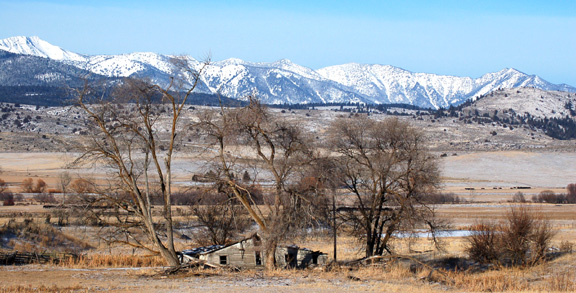- Wolf News
----- Who Killed The Wenaha Wolf? (Video)
----- State & Congressional Legislators Attempting to Remove Protections for Wolves
----- Wolves In Umatilla County
- Oxbow Reservoir Eagles & Bighorn Sheep (Scroll through wolf articles for eagle and bighorn ewe photos)
__________
Who Killed The Wenaha Wolf?
Watch on YouTube.
From WolfAdvocates:
The young male Wenaha Wolf lived in the Umatilla National Forest of the Blue Mountain Range, in the Wenaha-Tucannon Wilderness. He was fitted with a radio collar in early August, and shot dead by an unknown assailant in early October 2010. That person likely had a receiver tuned to his frequency who tracked him down and brutally shot him in his home territory.
The Wenaha wolf pack has never been associated with one single instance of depredation. The killing of this beautiful wolf was not only cruel and illegal, it was unjustified in every sense of the word. If you have any information that can lead to the arrest and conviction of the one who killed the Wenaha Wolf, we urge you to call the U.S. Fish & Wildlife Service at 503-682-6131.
To learn more about Oregon wolves, please visit Bringing Wolves Back Home to Oregon
__
State & Congressional Legislators Attempting to Remove Protections for Wolves

Fish & Wildlife Service Photo (above)
Oregon Wild Press Statement on Whitsett Wolf Kill Bill Introduction
PORTLAND, ORE Feb 03, 2011
On February 1, 2011, state Senator Ted Whitsett [District: 28, Klamath Falls, 541-883-4006, sen.dougwhitsett@state.or.us - Chris], introduced Senate Bill 583 which seeks to remove the gray wolf from protection under the state endangered species act. The bill is the first of many expected legislative efforts aimed at undermining the Oregon Wolf Conservation and Management Plan, adopted in 2005 after months of stakeholder meetings and negotiations. The following is the reaction of Rob Klavins of the conservation group Oregon Wild, a leading voice for wolves in Oregon:
“This wolf kill bill is a dangerous distraction from sincere efforts to recover and manage gray wolves in Oregon. It is sad that 60 years after wolves were eradicated in our state through poisoning and trapping some feel we should turn back the clock to those dark days. Wolves are native to Oregon and have a place on the landscape of our state. Just days after confirming 3 new wolves in Oregon, the state’s known population stands at 24 wolves and 2 breeding pairs. Now is not the time to repeat the mistakes of the past and send them back down the path to extermination.
This extreme bill takes wildlife management decisions out of the hands of professional biologists, and plays politics with what should be a scientifically-based process. In addition, we are fearful that this proposed legislation represents the tip of the iceberg of anti-wolf bills to be proposed during this legislative session. Oregon Wild will work to ensure we don’t take a step back in our efforts to recover gray wolves to the state and continue our efforts to educate Oregonians about the benefits of this once maligned animal returning to Oregon.”
Text of bill:
Relating to wolves.
Be It Enacted by the People of the State of Oregon:
SECTION 1. Notwithstanding any provision of ORS 496.171 to 496.182, the State Fish and Wildlife Commission may not list the gray wolf on the list of wildlife species that are
threatened species or endangered species adopted by rule of the commission pursuant to ORS
496.172.
_
Rehberg sets the stage for nationwide wolf eradication
New legislation would allow elimination of gray wolves, puts all America’s wildlife at risk
Washington, DC (January 27, 2011) - Montana Rep. Denny Rehberg introduced two bills yesterday that would strip federal protections for gray wolves across the country. Together, these bills would allow states to eliminate all wolves in the Northern Rockies, Great Lakes and Southwest, including the 42 Mexican wolves struggling for survival in New Mexico and Arizona. If passed, this legislation would be the first to exempt a single species from the Endangered Species Act, setting a dangerous precedent for removing protections for other imperiled wildlife.
The following is a statement from Rodger Schlickeisen, president of Defenders of Wildlife:
“These bills are bad for wolves, bad for the Endangered Species Act, and bad for the future of all America’s wildlife. Some members of Congress are willing to sell out America’s wolves by looking for a quick legislative fix. In the process, they are undermining not only one of our greatest conservation successes, but also unraveling the Endangered Species Act, one of the world’s most far-sighted conservation laws.
“Most Americans care very deeply about our nation’s wildlife and want to see all animals protected from needless persecution. However, these bills would sacrifice wildlife belonging to all Americans just because a small minority of people don’t like wolves. Obviously, some folks still think all predators are bad, even though those animals are an essential part of this country’s wildlife heritage.
“These bills set a terrible precedent that will open the flood gates to legislation to strip protections for any other species that a politician finds inconvenient to protect. Grizzly bears, salmon, whales, polar bears and Florida panthers are just a few that could be at serious risk. If enacted, this legislation would constitute one of the worst assaults on the ESA since it became law in 1973. If we allow Congress to overrule the courts and usurp the authority of professional wildlife managers and expert biologists, there’s no telling where it will stop.
“For decades there has been a worldwide scientific consensus that human society is causing a rapid and accelerating loss of species, species that hold together the web of life that supports all life on earth, including human life. During President George H. W. Bush’s administration, his science advisory council identified this phenomenon as representing one of the most serious long-term threats to human welfare, and it has only become worse since then. The ESA is the single strongest law we have for combating this enormous threat to future generations, and it would be enormous human folly to mindlessly begin unraveling it based upon political whim.
. . . .
Background:
On August 5, 2010, federal protections were restored for wolves in the Northern Rockies under the Endangered Species Act. A U.S. District Court in Montana determined that wolves had been illegally delisted along state lines by removing protections in Idaho and Montana but not Wyoming.
Under current delisting plans, Idaho, Montana and Wyoming would have been allowed to manage wolves down to 100 to 150 wolves per states. Wyoming’s plan would allow wolves to be shot on sight in 90 percent of the state. Idaho’s official position, as adopted by the Idaho state legislature in 2002, is to remove all wolves by any means necessary. The 2002 Idaho state wolf management plan calls for no more than 150 wolves. Montana has so far committed to maintaining a minimum of 15 breeding pairs, but there is nothing to prevent the state legislature or future administrations from using this number as the maximum as well. There are currently an estimated 1,700 wolves in the region. More than 1,000 wolves could needlessly die because of this legislation.
At the last count in January 2010, biologists could find just 42 Mexican gray wolves and only two breeding pairs in Arizona and New Mexico – a dangerously low number that scientists say contributes to ongoing genetic inbreeding that is causing low birth and pup survival rates, creating a downward demographic spiral. The population dropped by 19 percent between 2009 and 2010. A new count is being conducted this month.
###
Links:
http://www.defenders.org/programs_and_policy/wildlife_conservation/imperiled_species/wolves/wolf_recovery_efforts/northern_rockies_wolves/index.php
Read a chronology of wolf recovery in the Northern Rockies
[See link above for entire article.]
__
Wolves In Umatilla County
From ODFW: Michelle Dennehy
Feb 2, 2011
You may have already seen this in the news or heard it elsewhere…
Track evidence found by ODFW and U.S. Forest Service biologists on Jan. 20 confirms that three wolves have
been using the Walla Walla Unit and represent a potential new wolf pack. The wolves’ territory is not clear yet; they
could be primarily using territory in Washington State. There is currently no evidence that these wolves reproduced
in 2010.
_
MILTON-FREEWATER
Wolf pack confirmed in Umatilla County
Posted: Monday, January 31, 2011 2:39 pm | Updated: 3:16 pm, Mon Jan 31, 2011.
By PHIL WRIGHT
East Oregonian
Wolves are now living in northern Umatilla County, a state wildlife official confirmed today.[See link above for article.]
Mark Kirsch is the Umatilla District wildlife biologist with the Oregon Department of Fish and Wildlife. He said more than one Northern Rocky Mountain gray wolf has settled in the Walla Walla River/Mill Creek system.
"When we say more than one wolf, I think we're pretty confident we have no less than three," Kirsch said.
But it's too early to say just what kind of "social formation" these wolves are in, he said.
"We know so little at this point," Kirsch said. "The source of our current efforts is to try and understand that."
Andrew Picken of Pendleton reported seeing a trio of wolves south of Milton-Freewater on Jan. 2. He even shot some video and took photos, but the animals were too far away to positively identify them as wolves.
__
Oxbow Reservoir Eagles & Bighorn Sheep
 Bald Eagle Near Brownlee Dam, February 2, 2011
Bald Eagle Near Brownlee Dam, February 2, 2011[Some sort of incompatibility between Google and Photoshop puts too much blue in this photo. I've tried to correct it to no avail!]
I took Joanne Britton's (our local bird historian and count organizer) advice and went out to enjoy the sunshine on Tuesday & Wednesday of last week. Saw 14 Bald Eagles on the Powder River arm of Brownlee Reservoir on Tuesday (Don't have a scope so there may have been more.) There were also 5 on a cow carcass in the lower Keating/Powder River Valley near Middle Bridge, and 4 golden eagles enroute to Brownlee. Couldn't find the Hooded Mergansers that Jim Lawrence had seen on an open pond near there a week or so earlier.
Quite a few Common Goldeneye have returned to the Powder, which is flowing with ice-melt.
 Common Goldeneye, Powder River, March, 2010
Common Goldeneye, Powder River, March, 2010On Wednesday, February 2 (Groundhog Day), I went down to Oxbow on the Snake River and counted 52 BAEA between Oxbow dam and Brownlee dam, including 20 juveniles. Most were perched in the larger trees (with a few on the shoreline) on the Idaho side, but several were on the Oregon side. Both adults and juveniles were in flight around Brownlee Dam. Posted some of the eagles on Flickr.
 Juvenile Bald Eagle, Brownlee Dam, February 2, 2011
Juvenile Bald Eagle, Brownlee Dam, February 2, 2011 Rocky Mountain Bighorn Ewe near Brownlee Dam, 2/2/11
Rocky Mountain Bighorn Ewe near Brownlee Dam, 2/2/11Four Bighorn ewes were grazing on grasses just off the road on the Oregon side. One had a collar and a number 99 tag. Wish I knew more about her. The fur had been considerably shortened on her neck around the collar.
 Rocky Mountain Bighorn Ewe with collar near Brownlee Dam, 2/2/11
Rocky Mountain Bighorn Ewe with collar near Brownlee Dam, 2/2/11












2 comments:
the movie is sad.
who killed the it?
Will we ever know? They work in a dark and hard-hearted world.
Post a Comment